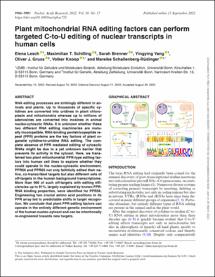Lesch, Elena; Schilling, Maximilian; Brenner, Sarah; Yang, Yingying; Gruss, Oliver; Knoop, Volker; Schallenberg-Rüdinger, Mareike: Plant mitochondrial RNA editing factors can perform targeted C-to-U editing of nuclear transcripts in human cells. In: Nucleic Acids Research. 2022, vol. 50, iss. 17, 9966-9983.
Online-Ausgabe in bonndoc: https://hdl.handle.net/20.500.11811/10756
Online-Ausgabe in bonndoc: https://hdl.handle.net/20.500.11811/10756
@article{handle:20.500.11811/10756,
author = {{Elena Lesch} and {Maximilian Schilling} and {Sarah Brenner} and {Yingying Yang} and {Oliver Gruss} and {Volker Knoop} and {Mareike Schallenberg-Rüdinger}},
title = {Plant mitochondrial RNA editing factors can perform targeted C-to-U editing of nuclear transcripts in human cells},
publisher = {Oxford University Press},
year = 2022,
month = sep,
journal = {Nucleic Acids Research},
volume = 2022, vol. 50,
number = iss. 17,
pages = 9966--9983,
note = {RNA editing processes are strikingly different in animals and plants. Up to thousands of specific cytidines are converted into uridines in plant chloroplasts and mitochondria whereas up to millions of adenosines are converted into inosines in animal nucleo-cytosolic RNAs. It is unknown whether these two different RNA editing machineries are mutually incompatible. RNA-binding pentatricopeptide repeat (PPR) proteins are the key factors of plant organelle cytidine-to-uridine RNA editing. The complete absence of PPR mediated editing of cytosolic RNAs might be due to a yet unknown barrier that prevents its activity in the cytosol. Here, we transferred two plant mitochondrial PPR-type editing factors into human cell lines to explore whether they could operate in the nucleo-cytosolic environment. PPR56 and PPR65 not only faithfully edited their native, co-transcribed targets but also different sets of off-targets in the human background transcriptome. More than 900 of such off-targets with editing efficiencies up to 91%, largely explained by known PPR-RNA binding properties, were identified for PPR56. Engineering two crucial amino acid positions in its PPR array led to predictable shifts in target recognition. We conclude that plant PPR editing factors can operate in the entirely different genetic environment of the human nucleo-cytosol and can be intentionally re-engineered towards new targets.},
url = {https://hdl.handle.net/20.500.11811/10756}
}
author = {{Elena Lesch} and {Maximilian Schilling} and {Sarah Brenner} and {Yingying Yang} and {Oliver Gruss} and {Volker Knoop} and {Mareike Schallenberg-Rüdinger}},
title = {Plant mitochondrial RNA editing factors can perform targeted C-to-U editing of nuclear transcripts in human cells},
publisher = {Oxford University Press},
year = 2022,
month = sep,
journal = {Nucleic Acids Research},
volume = 2022, vol. 50,
number = iss. 17,
pages = 9966--9983,
note = {RNA editing processes are strikingly different in animals and plants. Up to thousands of specific cytidines are converted into uridines in plant chloroplasts and mitochondria whereas up to millions of adenosines are converted into inosines in animal nucleo-cytosolic RNAs. It is unknown whether these two different RNA editing machineries are mutually incompatible. RNA-binding pentatricopeptide repeat (PPR) proteins are the key factors of plant organelle cytidine-to-uridine RNA editing. The complete absence of PPR mediated editing of cytosolic RNAs might be due to a yet unknown barrier that prevents its activity in the cytosol. Here, we transferred two plant mitochondrial PPR-type editing factors into human cell lines to explore whether they could operate in the nucleo-cytosolic environment. PPR56 and PPR65 not only faithfully edited their native, co-transcribed targets but also different sets of off-targets in the human background transcriptome. More than 900 of such off-targets with editing efficiencies up to 91%, largely explained by known PPR-RNA binding properties, were identified for PPR56. Engineering two crucial amino acid positions in its PPR array led to predictable shifts in target recognition. We conclude that plant PPR editing factors can operate in the entirely different genetic environment of the human nucleo-cytosol and can be intentionally re-engineered towards new targets.},
url = {https://hdl.handle.net/20.500.11811/10756}
}






